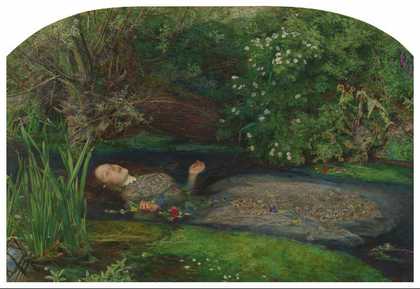
Sir John Everett Millais, Bt
Ophelia (1851–2)
Tate
Perhaps to appreciate this picture, one has to be a water baby – the type of person happiest when swimming, or soaking in a deep bath; someone who can truly relish that mind-altering sensation of water lapping against skin. Millais’s painting should be about death and misery and madness, but it always evokes in me positive associations. It is the prominence of water and the lush greenery which tantalise the senses and allow the viewer to feel his or her consciousness moving beyond Shakespeare’s doomed heroine, or Dante Rossetti’s equally doomed lover – the model for whom was Elizabeth Siddal. The stream appears to be cool, rather than cold. It is welcoming and inviting. The flowers floating on its surface are so freshly picked one can almost smell them, revel in the scent of the dew that would have been on them when plucked and feel their gratitude as they drink in the water bursting around their stems.
The current that appears to flow so gently past her outstretched hand seems evocative of a time when most of Europe’s rivers weren’t polluted. It harks back to a bucolic heaven (perhaps one that never existed, but which we like to believe did) when young village maidens, exhausted by a day’s hard labour, would cool their aching limbs and slake their thirst in the nearest river. Imagine that fantastic opportunity: water so pure one could even drink it without risking chemical poisoning.
Although this painterly water barely ripples at the surface, we are seeing the stream in its calmest moment. The patterning of the weed suggests it can mutate into a fast-flowing, exhilarating river, in which young lads could splash and compete in the style of E.M. Forster’s or D.H. Lawrence’s prose. A river in which one could become a mermaid.
If I stare long enough at Millais’s rendering of the water, it can return me to a trance-like state of my own water-based memories. Of being a small child swimming in an outdoor pool. I loved that pool. It was shaded by thick trees, and in the late afternoon, when the sun had moved behind them, their shadows afforded the illusion of a green river. In my imagination it became wild unbounded water instead of a safe rectangular pool (hemmed in by tiles and concrete) – a Swallows and Amazons world of rushing rivers, through which brave explorers journeyed to find exotic wildlife and treasure. It also transports me back in time to adult months spent in New Zealand, where lakes and rivers are still unpolluted and safe. It evokes that unparalleled sensation of sun-warmed skin, made grimy with hours of dusty walking and travelling, being cooled by the purest of water.
Ophelia’s death throes can be read as a moment of ecstasy. An ecstasy experienced by a woman usually trammelled by the conventions of her society, or of her imagination, who has come to regard her existence as mere drudgery, and who has finally found freedom.
Lucinda Hawksley is a freelance writer. Her book Lizzie Siddal: The Tragedy of a Pre-Raphaelite Supermodel is published by Andrew Deutsch.
